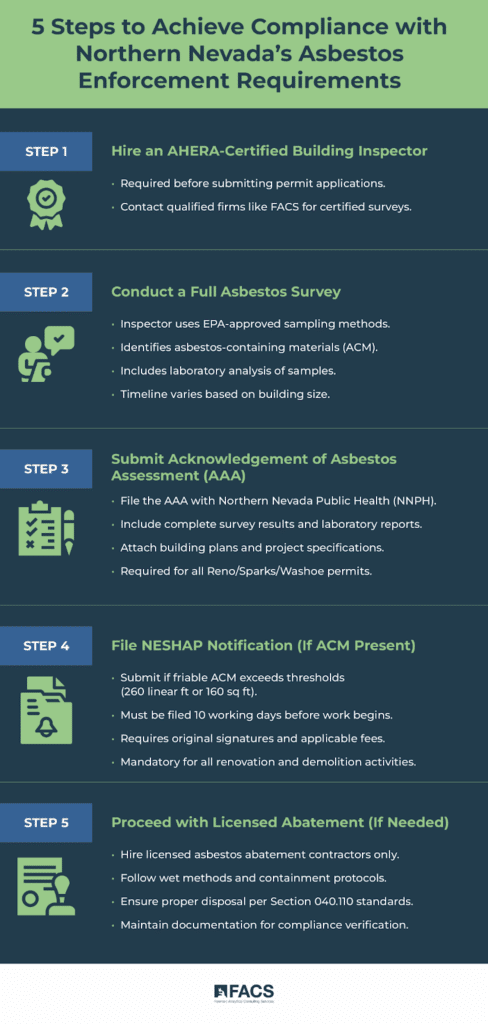The FACS Nevada office reported a surge in demand for asbestos surveys. Requests for AHERA-certified surveys to our office have spiked from clients seeking to secure building permits from the City of Reno and City of Sparks. The uptick stems from heightened enforcement by Northern Nevada Public Health (NNPH) of long-standing federal rules that specifically emphasize the use of certified inspectors for commercial projects.
While the core regulations under the National Emission Standards for Hazardous Air Pollutants (NESHAP) date back to the 1990s, NNPH’s recent push for compliance with AHERA-certified surveys is changing how local contractors and developers approach renovations and demolitions. Owners and contractors who aren’t aware of the stricter enforcement are being notified their demolition or building permit applications are now on hold pending the performance of those surveys by accredited AHERA Building Inspectors.
Background on Asbestos Regulations
Asbestos, a naturally occurring mineral once widely used in building materials for its durability and fire resistance, poses significant health risks when disturbed. Inhalation of its fibers can lead to serious conditions like asbestosis, lung cancer, and mesothelioma, prompting stringent regulations to protect public health.
At the federal level, the regulatory foundation lies in the NESHAP, part of the Clean Air Act administered by the U.S. Environmental Protection Agency (EPA). Originally promulgated in 1973, the standards underwent major revisions in 1990 to address demolition and renovation activities more comprehensively. These rules require thorough inspections for asbestos-containing materials (ACM) before any work that could disturb them, along with notifications to regulatory authorities to ensure safe handling and disposal.
Complementing NESHAP is the Asbestos Hazard Emergency Response Act (AHERA) of 1986, initially focused on schools but extending standards for inspector certification. AHERA mandates that surveys be conducted by accredited professionals trained in identifying and sampling ACM, using protocols that ensure accurate assessment and risk management.
Recent Changes in NNPH Heightened Enforcement
It’s important to note that these are not entirely new rules. The EPA NESHAP regulations have been in place since 1970. However, NNPH—serving Washoe County, including Reno and Sparks—has heightened enforcement, particularly requiring AHERA-accredited Building Inspectors for asbestos surveys as a prerequisite for building permits. This shift aligns with revisions to Section 040.110 of the District Board of Health Regulations Governing Air Quality Management, adopted on March 27, 2025, following public hearings and workshops.
The updates clarify requirements for sampling, notifications, and abatement, emphasizing the Acknowledgement of Asbestos Assessment (AAA) form submission before permit issuance. A key driver appears to be enhanced public health protections and alignment with EPA-delegated authority, as evidenced by NNPH’s September 12, 2025, workshop on renovation and demolition guidelines, which addressed common compliance questions. This enforcement wave follows earlier public comment periods in January 2025 and proposed revisions discussed in November 2024.
Impact on Local Construction and Building Projects
The updated requirements are noticeably affecting project timelines in Reno and Sparks. Building permits there that call for an AAA from NNPH now require a certified asbestos survey, potentially delaying project starts by weeks if not planned early.
This underscores the immediate demand and why local firms are seeking specialized support from FACS due to the AHERA Building Inspector stipulation. Non-compliance risks fines that can far outweigh the investment. On the positive side, compliance fosters safer work environments and reduces potential liabilities.
How to Comply: Steps for Asbestos Surveys and Permits
Navigating these requirements starts with proactive planning. First, engage an AHERA-accredited Building Inspector to perform a thorough survey, following EPA and NNPH protocols for sampling and analysis of potential ACM. FACS inspectors are qualified to perform those surveys.
Submit the AAA application to NNPH via your online portal or email, including survey results, building plans, and lab reports. If friable asbestos-containing materials exceed regulatory thresholds (e.g., 260 linear feet or 160 square feet), a NESHAP Notification of Renovation or Demolition must follow, submitted at least 10 working days in advance with original signatures and payment.
For abatement, use licensed contractors adhering to wet methods, containment, and disposal standards outlined in Section 040.110.
- Step 1: Hire Inspector – Engage AHERA-certified professional; required before permit application.
- Step 2: Conduct Survey – Inspect for asbestos using EPA-approved methods; timeline varies by building size; include lab analysis.
- Step 3: Submit AAA – Apply to NNPH with survey results and plans; required for permits in Reno/Sparks/Washoe.
- Step 4: NESHAP Notification – If ACM present, notify 10 days in advance; includes fees, original signature; mandatory for renovations/disturbances.
- Step 5: Abatement if Needed – Remove or manage ACM safely; by licensed contractors; follow containment protocols.
NNPH’s renewed focus on NESHAP through AHERA-certified surveys represents a much-needed step toward safeguarding community health, even as it introduces new layers to the permitting process. By understanding these requirements and partnering with experienced providers, stakeholders can minimize disruptions and ensure smooth project execution. FACS suggests you turn the hassle of compliance into an opportunity for safer, more efficient builds.
For more information or to schedule your survey now, call FACS at (888) 711-9998 or contact us online here: https://facs.com/contact-us.
